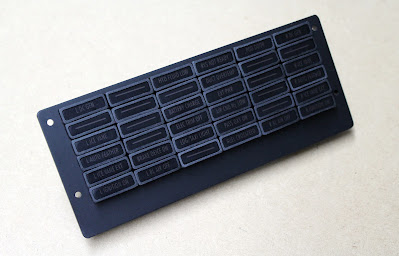As well as continuing with the fixed wing variety, we've also been doing a lot of work lately with some new products related to helicopter flight simulation. More specifically, our new range will be based around the Bell 206. Our designs for these products have been geared around the
DodoSim FSX206 software and to enable actual encoders, toggle switches, buttons, and circuit breakers to be used instead of key-presses and mouse-clicks, we have written special code for our I/O boards.
This specially written code allows the use of one each of our 64Input Boards and 64Output Boards to interface to the
DodoSim FSX206 software through FSX and FSUIPC so that all of the following controls work correctly :
- Annunciators (including press to test)
- Fuel Valve Switch
- TOT Button
- Warning Mute Button
- GPS/NAV Switch
- Altimeter (QNH) setting Encoder
- Course setting Encoder
- Heading setting Encoder
- ADF setting Encoder
- VOR setting Encoder
- Hydraulic Switch
- Anti-Icing Switch
- Dim Caution Lights Switch
- Generator Switch
- Avionics Switch
- Battery Switch
- Position Lights Switch
- Instrument Lights Switch
- Anti-Collision Lights Switch
- Dir/Gyro Switch
- Pitot Heat Switch
- AFT Fuel Pump Circuit Breaker
- FORE Fuel Pump Circuit Breaker
- Caution (Annunciator) Circuit Breaker
- Generator Field Circuit Breaker
- Difficulty Level (We use a Rotary Encoder)
- Audio Ident Switches
The majority of this work has already been done and we've had the programs running in our workshop over the past few weeks.
Matters of the more external nature took something of a leap forward yesterday however, with the completion of our newly-designed Bell 206 Annunciator Panel (shown below).
The annunciators we've designed here are individual replicas of a korry
we've had in our workshop for a while: a beautifully engineered work
of art manufactured by Les Modeles Francais.
Below is a photograph of one of our early prototypes
alongside the original LMF Korry.
The fact that these annunciators are built as separate units means that they
are readily replaced or upgraded as per the needs of each individual
customer. As our software has been designed around the DodoSim
layout however, that is the typical configuration that we would supply.
This annunciator panel fits the Bell 206 MIP we've been developing also,
which is being constructed along similar lines to the
King Air MIP panels that we already sell.
Below are a series of photos which show the annunciators under different
conditions. The first, as attested to by the 'glass'(!), is under the bright
fluorescent light above one of our workspaces. The legends are readable
(though barely), and it's obvious that none of them are lit; hence all is well.
Below, in the same bright conditions, we now have one of the annunciators lit.
And finally, we see how the same annunciator would likely appear in a
darkened simulator. The light bleed at the rear, and the wires extending
from the LEDs, would not be seen in the final product of course,
as these photos are presently just for demonstration purposes.
Once we have this annunciator panel fitted to the MIP and interacting































.jpg)
.jpg)
.jpg)


.jpg)
.jpg)





.jpg)









